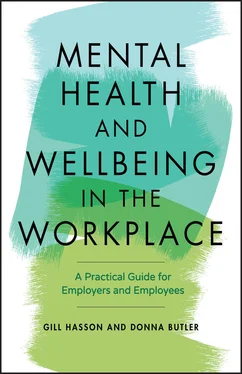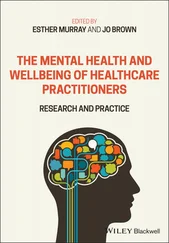Managing mental health and wellbeing at work starts with understanding what mental health and wellbeing are. In Chapter 1we explain this. We also explain what mental ill-health is and we describe the signs and symptoms of some common mental illnesses. Our mental health and wellbeing can change not just from day to day, month to month, and year to year, but at key stages and changes in our lives; you'll also read in Chapter 1how some key life stages can adversely impact on our mental health and wellbeing.
In Chapter 2we look at the impact that work can have on our mental health and wellbeing. We ask the question ‘Is work good for you?’ The answer is yes. And no. The research consistently reflects what we all already know: people are suffering at work; they're finding the increasing demands of work pressure untenable.
Issues such as a poor working environment, unrealistic deadlines, poor communication, poor interpersonal relationships, too much responsibility, and a lack of management support can significantly impact on the wellbeing of people at work. People get stressed. Especially if they're also dealing with difficulties and problems outside of work. People get stressed when they feel overwhelmed or unable to cope as a result of pressures and demands that are unmanageable; when they feel they have little control over a situation.
It doesn't have to be this way! In recent years, there's been plenty of interest and research telling us how to turn things around. In 2017, for example, an independent review – Thriving at Work – led by mental health campaigner Lord Dennis Stevenson and Paul Farmer, chief executive at Mind and chair of the NHS Mental Health Taskforce. Thriving at Work sets out a framework of core standards that all UK employers, it suggests – no matter what their size or the industry in which they operate – can implement to address workplace wellbeing and mental health.
In Chapter 3we explain how organizations and managers at all levels can implement some of the recommendations made in the Thriving at Work review. You'll read how to assess, improve, and maintain wellbeing in the workplace. In other words, how to be a good place to work.
Of course, it's not all down to organizations and their leaders to up their game. There's a lot that individual employees can do to develop their own wellbeing and resilience. Chapter 4has a wealth of practical advice and suggestions that can help individuals to, amongst other things, have a healthy work–life balance, manage stress at work, create positive relationships with colleagues, and look after their physical health at work.
However, although there's plenty that each of us can do to develop and maintain our wellbeing, we're not invincible. For one reason or another, any of us can experience a mental illness. In Chapter 5we look at how best to manage at work if you have been or are currently unwell. We explain the importance of identifying what could trigger a downturn, what you can do to help yourself to be well, and what to do in a crisis. Throughout this chapter and the previous one, we emphasize the importance of not needing to do any of this – looking after your mental health and wellbeing – on your own. There is help and support out there.
In the last chapter – Chapter 6– we write about how managers can help and support employees with mental health problems. There's a lot to take into account, but if you are a manager, do be reassured that no one is expecting you to know all the answers, or to know as much as a trained mental health professional. But having some knowledge, understanding, and training in mental health will help you know when and how far you can help, when to ask for support, and when to refer someone to other agencies.
Employers that genuinely promote and value wellbeing and good mental health and support people – whatever their culture, beliefs, and abilities – with mental health problems are more likely to create conditions that allow for everyone to give of their best, to be committed to their organization's goals and values, to be motivated to contribute to organizational success, to feel valued and supported, and to have a positive sense of their own wellbeing.
1 Understanding Mental Health and Wellbeing
Defining Mental Health and Wellbeing
The World Health Organization (WHO) defines mental health as: ‘A state of well-being in which every individual realizes his or her own potential, can cope with the normal stresses of life, can work productively and fruitfully and is able to make a contribution to her or his community’.
Our mental health affects the way we experience the world; how we think, feel, and behave towards ourselves and others. WHO defines mental health as a ‘state of well-being’ and just as physical health is intrinsic to wellbeing, so is mental health.
The mental health organization ‘Mind’ suggests that if you have good mental wellbeing you are able to:
feel relatively confident in yourself and have positive self-esteem
feel and express a range of emotions
build and maintain good relationships with others
feel engaged with the world around you
live and work productively
deal with the stresses of daily life
adapt and manage in times of change and uncertainty.
Both Mind and the World Health Organization's definition of mental health refer to a person's wellbeing. But is wellbeing the same as wellness?
When you think about wellness, think prevention and health. When you think about well-being, think happiness.
Susie Ellis. Chair of the Global Wellbeing Institute
Certainly, happiness is important, but there is more to wellbeing than the positive feelings that come with happiness. Both WHO and Mind recognize that wellbeing involves not just happiness, but crucially, the ability to manage difficulties, problems, and challenges; the ‘normal stresses’.
In 2012, Cardiff Metropolitan University Professors Rachel Dodge and Annette P. Daly et al. published their report The Challenge of Defining Wellbeing . Having reviewed and analyzed past attempts by other researchers to define wellbeing, they concluded that ‘it would be appropriate for a definition of wellbeing to centre on a state of equilibrium or balance that can be affected by life events or challenges’. Consequently they define wellbeing as: ‘the balance point between an individual's resource pool and the challenges faced’.
In other words, wellbeing occurs when a person is able to enjoy life andhas the resources to draw on to manage life's ups and downs without feeling overly stressed. Therefore, an important component of wellbeing is resilience; the ability to cope with, as well as bounce back and recover from, difficulties and challenges.
Dimensions of Wellbeing; Social and Spiritual
There is no health without mental health.
World Health Organization
One of the key aspects of mental wellbeing is our social wellbeing; the ability to build and maintain good relationships with others. Social wellbeing is the extent to which you feel a sense of belonging and social inclusion. The UK Faculty of Public Health suggests that social wellbeing is ‘the basis for social equality and the antidote to issues such as racism, stigma, violence and crime’ and that it is dependent on, amongst other things, ‘the norm with regard to interpersonal relationships in a group, community or society, including respect for others and their needs, compassion and empathy, and authentic interaction’.
Another feature of wellbeing – just as important as social, mental, and emotional wellbeing, but not so widely acknowledged – is spiritual wellbeing. Spirituality refers to a sense of being connected to something bigger and more everlasting than yourself.
Читать дальше












